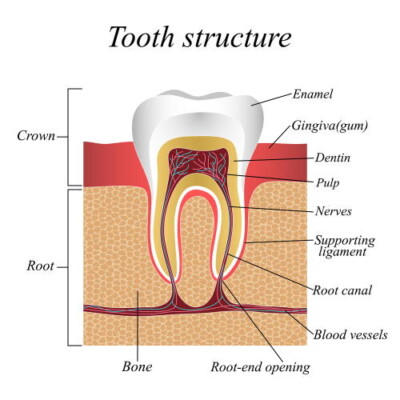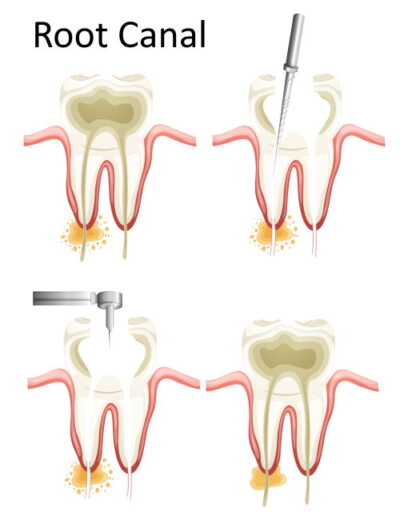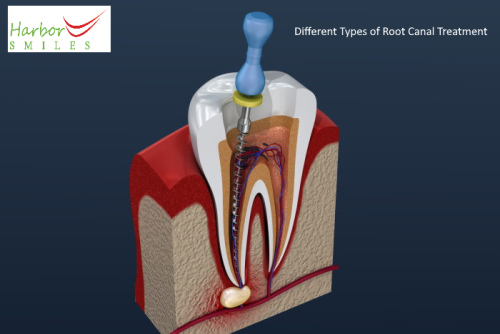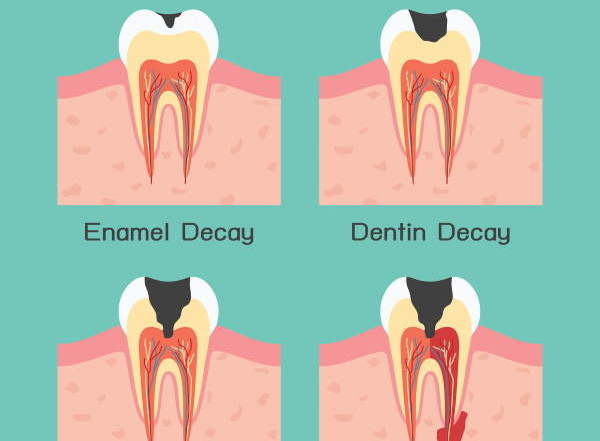Before, a broken tooth is usually extracted. However, this may lead to weaker bones and even bone loss. Fortunately, thanks to the advancement in modern dentistry, there is now a more secure way of saving a damaged or decayed tooth and that is the root canal treatment. Having natural teeth is better than having artificial ones because they function better.
Contents: What is a root canal? | Reasons for it? | Symptoms | Procedure | do I need Crown placement? | How to care after? | How much it costs? | Appointment | FAQ
Keep your Natural Teeth by removing root of the tooth
 A root canal is a type of endodontics treatment that focuses on saving the natural tooth which has become infected or damaged instead of permanently removing it. As the name implies, root canal treatment repairs the tooth by cleaning the canals inside of an infected tooth.
A root canal is a type of endodontics treatment that focuses on saving the natural tooth which has become infected or damaged instead of permanently removing it. As the name implies, root canal treatment repairs the tooth by cleaning the canals inside of an infected tooth.
It is important to know the anatomy of a tooth to further understand how the root canal works. Dental pulp or pulp chamber is a soft oral tissue under the white dental enamel and a hard layer called dentin. Inside the dentin are canals – anatomic spaces that naturally exist along the length of the root. Since the dental pulp is comprised of numerous nerve tissues, loose connective tissues, and blood vessels, when the pulp gets infected, inflamed, or irritated due to tooth decay, cracks, dental trauma, or undergoing frequent dental treatments, this may cause unbearable pain and may lead to tooth loss. An infected tooth may be saved through the root canal procedure by removing the infected pulp, cleaning the inside of the tooth, and sealing it with a dental crown.
How can a Tooth’s Root get Infected?
An infected root canal is a dental condition when bacteria attacks the inside of a tooth due to tooth decay, dental injury, a crack, a root fracture, or dental cavities. Continuous teeth restoration may also lead to an inflamed root canal. Dental caries or cavities are often caused by food particles stuck between the interdental spaces of the teeth especially in the surfaces of molars since they are constantly used for chewing food. If you neglect your dental care, the bacteria that is always existing in your mouth has the possibility of transforming sugar and carbohydrate content into acid. This acid can dwindle the protective properties of saliva on the dental enamel which eventually leads to tooth decay. If left as is, the dental pulp can be infected. Other possible diseases caused by cavities are the oral cavity, salivary gland, and jaw.
Not only do the bacteria in your mouth infect your teeth, but they can also affect your gums. This infection may lead to gum disease or periodontitis. Moreover, loosed gum tissues can lead to exposure of the dentin layer which results in infection of the connective tissue in the dental pulp.
There are several causes of infection in the tooth’s roots. However, regardless of the reason, it is essential to administer fast treatment because if it’s left untreated, it may lead to an abscessed tooth which results in tooth extraction. The abscess formed in the tooth is a pocket of pus caused by a bacterial infection. It develops around the root of an inflamed tooth and may cause discomfort or unbearable pain.
When is Emergency Root Canal Endodontic therapy needed?
 Saving a patient’s natural teeth is usually a priority of a dentist. There are other kinds of endodontics treatment but root canal therapy generally treats dental problems such as a dead nerve, infected or inflamed nerves, a cracked or decayed tooth. However, there are some cases when a root canal treatment is not the right solution. Such conditions include impacted wisdom teeth. This condition occurs when third molars erupt but don’t have sufficient space to grow. A dentigerous cyst may even develop around the unerupted tooth which is generally found on the lower quadrant and may require the impacted teeth’s extraction. In addition, pericoronitis – a complication when bacteria is formed around the soft tissue of a wisdom tooth – may occur causing inflammation which can be solved by removing the affected tooth. Supernumerary teeth and crowded teeth can also be resolved by tooth extraction.
Saving a patient’s natural teeth is usually a priority of a dentist. There are other kinds of endodontics treatment but root canal therapy generally treats dental problems such as a dead nerve, infected or inflamed nerves, a cracked or decayed tooth. However, there are some cases when a root canal treatment is not the right solution. Such conditions include impacted wisdom teeth. This condition occurs when third molars erupt but don’t have sufficient space to grow. A dentigerous cyst may even develop around the unerupted tooth which is generally found on the lower quadrant and may require the impacted teeth’s extraction. In addition, pericoronitis – a complication when bacteria is formed around the soft tissue of a wisdom tooth – may occur causing inflammation which can be solved by removing the affected tooth. Supernumerary teeth and crowded teeth can also be resolved by tooth extraction.
The patient and the dentist will have a consultation regarding the patient’s current dental condition before proceeding with the proper treatment. In the case that it has been decided to go with a root canal procedure, the therapy will only take two visits which is the minimum duration a normal root canal treatment usually takes. Give us a call for Same day Appointment for Emergency Root Canal..
Root Canal Step by Step procedure
-
Imaging
Visualization of the infected tooth’s damage and its composition is the first step of a root canal near Huntington Beach. An x-ray is usually conducted to determine this and for the endodontist to have a visible radiographic view of which roots are affected.
-
Anesthesia
A root canal therapy involves surgery and is usually painful since it involves the nerves. However, thanks to the local anesthesia, the pain is kept at a bare minimum.
-
Opening the Canal
In order to reveal the infected area, a hole is drilled through the enamel in the crown from the posterior teeth or the lingual side if the infected tooth is in the front.
-
Cleaning the infected tooth and removing root

After exposing the troubled areas, the infected nerve tissues will be removed and the canals will be thoroughly cleaned. Akin to this procedure is pulpotomy, a type of dental treatment involving the removal of the dental pulp within the crown and maintaining the pulp in the root canal. This procedure is usually done on children with decayed primary teeth.
-
Sealing
Gutta-percha is a plastic material for sealing the hole on the site of the affected tooth. A resin cement sealant is also utilized for the filling of the vacant space. It is essential to immediately fill the gap to prevent bacteria invading the hole.
-
Filling and Temporary Crown
A temporary restoration is used to cover the hole and to seal the end of the root canal. A few stitches are also done to help the tissue heal faster. A temporary crown may be planted to protect the tooth until a permanent crown is made.
-
Permanent Seal and Smile
The temporary sealing is interchanged with a permanent filling at the next visit once the tooth has healed and the patient has agreed.
Why is Crown placement necessary after Root Canal Surgery?
Undergoing root canal treatment nearby Huntington Beach will result in thinner walls of the tooth. Thus, it is advised to apply a dental crown to fortify it. We will provide a temporary crown once you decide to have a crown placed on your treated tooth. The imaging is then sent to the lab to create a permanent crown. Once done, it will then be fitted on your tooth. See Root Canal Cost near me
 If you are looking for a dental office that can provide a professional and comfortable dental experience, we at Harbor Smiles are happy to be of service. Schedule an Appointment if you’re near Huntington Beach, CA.
If you are looking for a dental office that can provide a professional and comfortable dental experience, we at Harbor Smiles are happy to be of service. Schedule an Appointment if you’re near Huntington Beach, CA.
FAQs on how to save your natural teeth
Is getting an endodontic treatment painful?
Root canal treatment is normally painful without local anesthesia. However, if anesthesia is used, most patients will only feel pain at a minimum according to the American Association of Endodontists. Meet Dr. Manali Patel DDS if you're near Huntington Beach CA.
Why does it take 2 visits?
A normal duration of a typical root canal treatment takes about two appointments. On the first appointment, the inflamed nerves and tissues are extracted and the tooth is covered. The affected root canals are then sterilized and cleaned to prevent infection on the second appointment. Visit our Harbor Smiles office near Huntington Beach.
Source:
Related Posts:
What are the Different Types of Root Canal?
A root canal is a dental procedure that is used to treat an infection or inflammation in the root of a tooth. The most commonly used type of root canal is the non-surgical root [...]
Prevent cavities in the following easy ways
Dental caries are corroded areas found in the tooth enamel that turn into tiny holes and further damage the tooth and the gum line. It is a typical oral problem that occurs when the [...]


